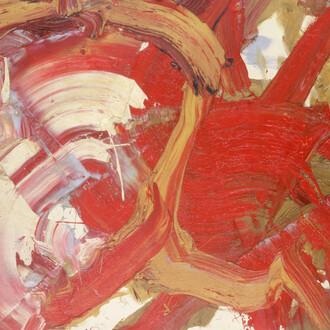A line takes a simple action and yet its outcome is diverse and elusive; the variations of its support material, length, width, direction, and shape give each line a unique expression, and such inherent instability of lines evokes spontaneity and experimentation in the images they compose.
Kishio Suga (1944-) constructs ephemeral arrangements of materials, both industrially manufactured and natural, via direct actions such as suspending, dropping, and stacking. Lines made visible by the arrangements explore the relationships between the individual, matter, and surrounding space.
Moriyuki Kuwabara (1942-) uses a compass and self-devised grids to paint countless circles that overlap and expand into a restless geometric composition, which is evocative of the tone of light and sound in transition. Best known for her enamel paintings of circles and lines resembling electrical circuitry, Atsuko Tanaka (1932-2005)’s drawings on paper unfold delicate hand-drawn lines freshly recording the movement of the artist’s hands. Such sensuous nature may refer to the physical and performative aspect of Tanaka’s early theatrical pieces.
Toshimitsu Imai (1928-2002) creates energetic abstract paintings using lines that derive from improvisational movements.
Yayoi Kusama (1929-)’s Infinity Nets are obsessive repetitions of linear patterns, which reveal an infinite expansion in the pictorial space and drifts between illusion and imagination.
Masaaki Yamada (1929-2010)’s paintings of stripes are a collection of repeated lines, which are drawn to mimic the outline of the canvas. Grounded in such internal formal logic, Yamada’s delicate lines stimulates our perceptual experience when facing a tableau.















